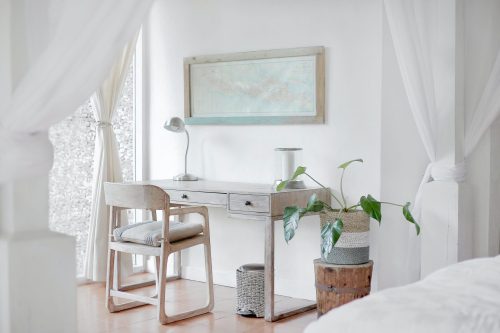In today’s fast-paced world, minimalism has emerged as a popular interior design style that offers a sense of tranquility and simplicity. This article explores the art of minimalism, guiding readers through the principles and techniques of creating serene interiors that promote clarity, mindfulness, and a harmonious living environment.

1. Understanding Minimalism
Minimalism is more than just a design trend; it is a philosophy that embraces the concept of “less is more.” By eliminating unnecessary clutter and focusing on essential elements, minimalism creates a serene and uncluttered space. Explore the core principles of minimalism, including simplicity, functionality, and intentional design choices.
2. Embracing Neutral Color Palettes
One of the key aspects of minimalistic design is the use of neutral color palettes. Discover how hues like whites, grays, beiges, and muted tones can create a serene ambiance. Learn how to strike a balance between light and dark shades, and explore the impact of natural light on the overall atmosphere of minimalistic spaces.
3. Streamlined Furniture and Essential Elements
Minimalism prioritizes clean lines, sleek furniture, and purposeful design. Explore the world of minimalist furniture and discover how to choose pieces that align with the principles of minimalism. From decluttering techniques to selecting functional furniture, find ways to create a sense of calm and openness within your living spaces.
4. Decluttering and Organization
Minimalism encourages a clutter-free environment that promotes mental clarity. Learn effective decluttering techniques and organization strategies to create serene interiors. Explore minimalist storage solutions, such as hidden storage compartments and multi-functional furniture, that help maintain a clean and uncluttered aesthetic.
5. Negative Space and Balance
Negative space, also known as empty or open space, plays a crucial role in minimalistic design. Discover how to use negative space strategically to create a sense of balance, harmony, and visual calmness. Explore techniques for arranging furniture, artwork, and décor to achieve a minimalist aesthetic with a focus on negative space.
6. Mindful Material Choices
The materials used in minimalist interiors contribute to the overall serene ambiance. Explore natural materials like wood, stone, and metal, and learn how to incorporate them in a way that complements the minimalist style. Discover the importance of quality over quantity when it comes to selecting materials for furniture, flooring, and finishes.
7. Functional Lighting Design
Lighting is a crucial element in minimalistic spaces, setting the mood and enhancing the overall tranquility. Explore the role of natural and artificial lighting in minimalist interiors. Discover different lighting techniques and fixtures that can create a soothing and serene atmosphere while maintaining functionality.
Creating serene interiors through the art of minimalism is about embracing simplicity, intentional design choices, and the promotion of tranquility. By incorporating the principles discussed in this article, you can transform your living spaces into havens of serenity that evoke a sense of calm and balance in your daily life. Embrace minimalism and experience the transformative power it holds.
